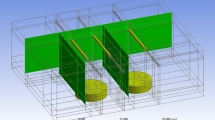The density distribution over the radius of porous permeable hollow cylinder produced by radial isostatic compacting is analyzed and calculated. The factors promoting an inhomogeneous density distribution in porous permeable materials during this type of compacting are determined by analytical calculations. It is proved that the optimal pore distribution across the section of porous permeable material providing maximum operating properties can be obtained by using the compacting procedure that allows relating the structural properties of the material with principal operating modes.




Similar content being viewed by others
References
S. V. Belov, P. A. Vityaz’, V. K. Sheleg, et al., Porous Permeable Materials: Handbook [in Russian], Metallurgiya, Moscow (1987), p. 332.
V. V. Mazyuk, L. P. Pilinevich, A. L. Rak, et al., Porous Powder Materials with Anisotropic Pore Structure for Filtering Liquids and Gases [in Russian], P. A. Vityaz’ (Ed.), Tonpik, Minsk (2005), p. 251.
B. F. Shibryayev, Porous Permeable Powder Materials [in Russian], Metallurgiya, Moscow (1982), p. 168.
R. A. Andrievskii, Porous Materials in Engineering [in Russian], Mashinostroyeniye, Moscow (1976), p. 184.
M. P. Anashchenko, L. P. Pilinevich, V. V. Savich, and A. L. Rak, “Porous materials from metallic powders for purifying potable, technical, and sewage waters,” in: New Resource-Saving Technologies and Improvement of Environment in Light Industry and Mechanical Engineering (Thesis Report at International Conference) [in Russian], Vitebsk (1998), pp. 269–271.
O. Yu. Povstyanoi, Improving Process for Producing Porous Powder Materials Using Waste Products of Industrial Production [in Ukrainian], PhD Thesis, Lutsk (2007), p. 170.
P. A. Vityaz’, V. K. Sheleg, and V. M. Kaptsevich, “Predicting properties of sintered permeable materials with variable cross-section porosity of bi-dispersed globular model,” Vys. Shkola, Minsk, No. 4 (1980), pp. 68–72.
I. M. Fedorchenko and N. A. Filatova, “Filtering properties of highly porous materials prepared from iron powders with nonspherical particles,” Powder Metall. Met. Ceram., 1, No. 3, 177–181 (1962).
B. A. Borok and I. I. Ol’khov, Powder Metallurgy: Handbook [in Russian], Metallurgizdat, Moscow (1948).
B. A. Borok, “Hydrostatic Pressing of Metallic Powders,” in: Powder Metallurgy (Report at 4-th All-Soviet Union Conference on Powder Metallurgy), Metallurgizdat, Moscow (1956), pp. 187–203.
M. B. Shtern, “Density–pressure dependence and density distribution during powder pressing,” Powder Metall. Met. Ceram., 53, Nos. 3–4, 139–147 (2014).
M. B. Shtern and O. V. Mikhailov, “Numerical modeling of the compaction of powder articles of complex shape in rigid dies: effect of pressing method on density distribution. I. Mechanical model of powder densification,” Powder Metall. Met. Ceram., 41, Nos. 11–12, 581–587 (2002).
O. V. Mikhailov, “Modeling densification of non-porous powder products tilted towards surface pressing direction,” Mathematical Models and Numerical Experiment in Material Science, No. 13, 90–95 (2001).
M. B. Shtern, “Development of the theory of pressing and plastic deformation of powder materials,” Powder Metall. Met. Ceram., 31, No. 9, 735–745 (1992).
M. B. Shtern and V. D. Dudunov, “Determination of the ultimate plastic capacity for powder materials based on the plastic flow model for porous solids. I. Criterion for exhaustion of the ultimate plastic capacity,” Powder Metall. Met. Ceram., 38, Nos. 11–12, 560–568 (1999).
O. Yu. Povstyanoi and V. D. Rud, “Determining radial density distribution of porous permeable cylinder during radial isostatic pressing,” Nauk. Notat. Lutsk. Nats. Tekh. Univ., No. 54, 246–252 (2016).
A. V. Kuz’mov and M. B. Shtern, “Effect of a third invariant on the properties and structure of constitutive relationships of powder materials,” Powder Metall. Met. Ceram., 42, Nos. 7–8, 329–335 (2003).
O. Yu. Povstyanoi, V. A. Sychuk, A. McMillan, et al., “Metallographic analysis and microstructure image processing of sandblasting nozzles produced by powder metallurgy methods,” Powder Metall. Met. Ceram., 54, Nos. 3–4, 234–240 (2015).
Author information
Authors and Affiliations
Corresponding author
Additional information
Translated from Poroshkovaya Metallurgiya, Vol. 56, Nos. 7–8 (516), pp. 68–78, 2017.
Rights and permissions
About this article
Cite this article
Povstyanoi, O.Y., Rud, V.D. Features of Radial Density Distribution During Radial Isostatic Compacting of Powders. Powder Metall Met Ceram 56, 416–423 (2017). https://doi.org/10.1007/s11106-017-9911-7
Received:
Published:
Issue Date:
DOI: https://doi.org/10.1007/s11106-017-9911-7




